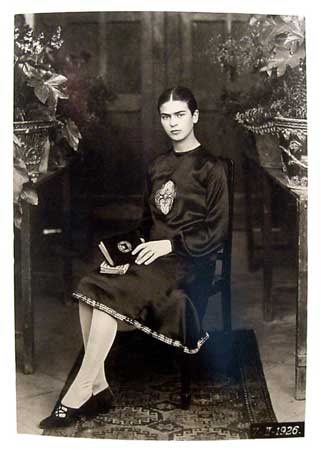Farrah Jawad
London, UK

“I paint myself because I am so often alone and because I am the subject I know best.” — Frida Kahlo
Frida Kahlo was born Magdalena Carmen Frieda Kahlo y Calderon in Coyocan, Mexico City, on July 6, 1907, to Matilde Calderon y Gonzalez, a woman of mixed Spanish and Mexican heritage, and Guillermo Kahlo, a German photographer. Frida was the third of four daughters and had two half-sisters. It is thought she was possibly born with spina bifida,1 as was reported by her friend and doctor, Leo Eloesser: “X-rays showed a spina bifida, the decreased sensitivity in the lower part of her body was characteristically compatible with this disorder.”2
She had a fraught relationship with her mother,3 witnessed the violence of the Mexican Revolution from the age of three, and contracted poliomyelitis at six, all of which may have had long-lasting effects on her emotional stress and her outlook on life. She spent several months in bed with poliomyelitis, and it left her with a right leg length discrepancy and deformity that required her to use a built-up shoe, for which she was teased by other children.1 Her father subsequently encouraged her to take up boxing, football, and wrestling,4 sports which would have been considered unusual for a young girl in Mexico at that time.
At the age of eighteen, a bus she was riding in was hit by a trolley car, and she suffered extensive injuries including fractures of her spine, pelvis, clavicle, ribs and several fractures throughout her right leg and foot. An iron handrail had pierced her abdomen and uterus. She required many operations after the accident and spent months convalescing in hospital. It was during her prolonged hospital admissions that she took to painting. The accident, the medical and surgical treatment she received afterwards, and long periods of intense pain and immobility had a profound effect on the expression of her art. Themes of pain and suffering feature heavily in her paintings, such as La Columna Rota (The Broken Column) and Autorretrato con Collar de Espinas (Self-Portrait with Thorn Necklace and Hummingbird). Kahlo had planned to study medicine prior to the bus accident.
Frida Kahlo married the Mexican painter Diego Rivera in 1929. Their relationship was stormy and both conducted extramarital affairs. Kahlo was bisexual and also had intimate relationships with women during this period, which her husband tolerated. They divorced in 1939 and remarried in 1940, but their second marriage was also unhappy. Kahlo conceived several times throughout her life, but because of the injuries she sustained during the bus accident, she miscarried several times and also had to terminate other pregnancies. The impact of these experiences can be seen in the painting Henry Ford Hospital where Kahlo depicts herself unclothed and crying on bloody sheets in a hospital bed, encircled by six abstract images related to miscarriage that emanate from her body via umbilical cords.
Kahlo endured widespread pain and fatigue throughout her life and may have suffered from post-traumatic fibromyalgia.5 She later had her right leg amputated due to gangrene, after which her morphine use reportedly increased, and she became more anxious and depressed. She developed bronchopneumonia which resulted in a further stay in hospital. She died in 1954 aged forty-seven. The cause of death recorded on her death certificate was pulmonary embolism. No post-mortem examination was carried out, and she was cremated in accordance with her wishes. A few days before her death, she wrote in her diary, “I hope the exit is joyful—and I hope never to return—Frida.”6 Since her death, Frida Kahlo has been renowned as one of the greatest artists of the twentieth century and also a feminist icon, due to her creative talent and subversion of social norms during her lifetime. She was dogged with ill-health throughout life, experiences which were both the stimuli for taking up painting and the subject matter of her artwork.
References
- Budrys, Valmantas. 2006. “Neurological Deficits In The Life And Works Of Frida Kahlo”. European Neurology 55 (1): 4-10. doi:10.1159/000091136.
- Sandblom, Philip. 1995. Creativity And Disease. New York, NY: Marion Boyars.
- Burrus, Christina, and Frida Kahlo. 2008. Frida Kahlo. London: Thames & Hudson.
- Siltala, Pirkko. 1998. “I Made A Picture Of My Life—A Life From The Picture: The Life Of The Body In The Pictures And Writings Of Frida Kahlo”. International Forum Of Psychoanalysis 7 (3): 133-155. doi:10.1080/080370698436808.
- Martínez-Lavín, Manuel, Mary-Carmen Amigo, Javier Coindreau, and Juan Canoso. 2000. “Fibromyalgia In Frida Kahlo’s Life And Art”. Arthritis & Rheumatism 43 (3): 708.
- Herrera, Hayden. 1983. Frida, A Biography Of Frida Kahlo. New York: Harper & Row.
FARRAH JAWAD, MD, is a registrar in Sport and Exercise Medicine in London, United Kingdom, having qualified from Barts and the London School of Medicine in 2008. She currently works at the Institute of Sport, Exercise and Health in London and is also a part-time MSc student in Performing Arts Medicine at University College London.
Highlighted in Frontispiece Volume 9, Issue 1 – Winter 2017 and Volume 13, Issue 3 – Summer 2021

Leave a Reply